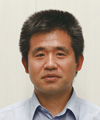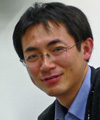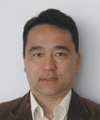 |
|||||
|
|
|||||
|
Feature Articles: Activities Toward Service Incubation to Speed Up R&D of Service Systems Vol. 11, No. 9, pp. 22–26, Sept. 2013. https://doi.org/10.53829/ntr201309fa4 Sweet Digital Home: Enhancing Family Life with HIKARI and CloudAbstractTo promote the further spread of the fiber-to-the-home (FTTH) network typified by the FLET’S HIKARI optical broadband service, there is a need for home services that can demonstrate the appeal of FTTH to general customers and persuade them to use HIKARI services over the long term. This article introduces the Sweet Digital Home (SDH) concept of visualizing and creating diverse home services to create a more comfortable family life. The goal here is to achieve advanced home services that are easy enough for anyone in the family to use based on a family cloud connected to the home via FTTH. This cloud will enable a wide range of family-related information to be collected and used across many services. 1. IntroductionOptical broadband services have been expanding steadily, as reflected by the more than 17.1 million subscribers (December 2012) to the FLET’S HIKARI* optical broadband service. However, if optical broadband is to spread even more, it is essential to provide attractive services that demonstrate the outstanding features of fiber-to-the-home (FTTH) technology so that existing FTTH customers will continue to subscribe for many years to come. One approach that NTT Service Evolution Laboratories is taking to realize such services is to visualize a variety of services based on the Sweet Digital Home (SDH) concept. This concept is targeted at home users, who make up a significant potion of NTT’s line subscribers, and is aimed at creating services that combine FTTH and a family-dedicated cloud (the family cloud). Such SDH services are intended to provide an environment in which family members can easily access the various types of data that are generated in daily life (digital photos, lifelogs, etc.) and stored on the family cloud over a high-quality broadband FTTH network [1]. However, the idea here is not simply to facilitate the storage and delivery of data through online storage. It is also to provide home services that add value to the data and that enable the data to be used in a straightforward and convenient manner using technologies developed by NTT laboratories and other service providers. We are now in the process of visualizing services based on the hypothesis that new home services based on the SDH concept will enable users to feel the true value of FTTH and will make everyday life even more convenient, pleasant, and comfortable the more that these services are used.
2. SDH service architectureThe detailed architecture of SDH services needs to be planned based on specific needs and usage environments, but we can consider it to have the basic configuration shown in Fig. 1.
These services will mainly target families that are already subscribing to an optical broadband service such as FLET’S HIKARI. We design the services to connect the family with the family cloud directly via the carrier’s managed network without the Internet as an intermediary. This type of configuration achieves a high level of security compared with online storage services that are now proliferating on the Internet. Additionally, the wideband characteristics of optical broadband as well as the high quality of a managed network (low delay, low loss, etc.) make for stress-free use of data-intensive content such as high-definition video. Here, it is important that the process of collecting data for the family cloud be trouble-free if home users without any detailed knowledge of information and communications technology (ICT) are to feel comfortable using SDH services. In these services, data will be collected mainly from the family’s home devices and from external services on the Internet using existing technologies such as a home device management platform (Home ICT etc.) and a service federation platform (OAuth etc.), respectively. The family cloud consists of three main functional blocks: a data storage function, data processing function, and service provision function. The data storage function stores user data in different storage areas, for example, in one for individual use and in another for family-wide use. Data sharing is facilitated in different ways such as between families and between family members living in the same home or in different places. The system controls the exchange of data between users for this reason. Furthermore, in addition to these standard online storage functions, the system will combine the data storage and the data processing function described below to perform advanced data processing such as recognizing data content and automatically adding annotations, learning user tastes and preferences from data-usage trends, etc. The data processing function consists of many engines that are elemental technologies transformed into reusable software modules for adding value and original features to stored data and services provided to users. These technologies consist of unique technologies developed by NTT laboratories and technologies that have been evaluated and studied in cooperation with outside organizations through open-innovation programs. The purpose of the service provision function, meanwhile, is to execute a variety of SDH services and provide them to the family as cloud services. Although the terminal software (user interface etc.) required for each service must be delivered to home terminals (such as telephones, televisions, tablets, and smartphones), technologies such as HTML5 (hypertext markup language version 5) help to minimize the configuring and upgrading of terminals when using new services with different functions. 3. Examples of SDH service visualizationWe have considered several services based on the SDH concept and have constructed a prototype system for demonstration purposes. We introduce here Omoide Frame and Family Cloud Browser as services that make browsing of content on the family cloud more convenient, and Yurukone, an advanced communication service using data on the family cloud (Fig. 2).
3.1 Omoide FrameWhat first comes to mind when considering the types of data that can be stored in the family cloud are photos and videos taken by users themselves. In many families, photos and videos taken with a digital camera or smartphone are simply left on the device’s memory card. Some ICT-savvy users may transfer their content to a personal computer and manage it there, while others may use an online storage service. In any case, finding photos or videos that one wants to view involves some work, namely, turning on the digital camera or personal computer, searching through old folders for the desired content, and launching an application to display it. The amount of work necessary to do this discourages many people from doing so, and thus limits the opportunities to see one’s photos and videos. It often happens that a photo or video is never viewed again after being taken. Moreover, while it is possible to display slide shows through the use of a digital photo frame, the content is usually displayed in a random manner. This method is therefore not conducive to viewing what one wants to view when one wants to view it. However, everyday activities in a household, for example, family members having conversations and watching television programs together in the living room, can stimulate spontaneous memories of past family activities. Even the day’s weather can remind people of past events. If photos and videos related to those memories can be presented at the time those recollections occur, a new way of enjoying photos and videos that keeps past memories close at heart can be achieved. The Omoide Frame service can display a slide show of family pictures stored on the family cloud using a digital photo frame and can narrow down the photos displayed by using speech recognition technology to recognize user-spoken keywords such as trip, father, and park. Plus, in addition to receiving input using spoken keywords, the service provides an interface for selecting photos through touch operations on a tablet computer to enable more complex searches using keywords such as AND-search and to support a non-targeted, casual style of browsing for viewing photos. 3.2 Family Cloud BrowserData stored on the family cloud can be quite diverse. In addition to photos and videos taken by users themselves, the data can include personal blogs and business sites on the Internet, video content such as video clips from the Internet and video on demand (VOD), and e-books. The family cloud can also be expected to collect data automatically on behalf of users and to deliver advertisements, the latest news, and other information from external sources. The family cloud can also be configured to enable the storage of information for referencing external data with links and bookmarks, thereby negating the need to store the data itself. In this case, the actual data are retrieved from an external site. However, accommodating such a wide range of data in a family cloud in this way would generally make it very difficult for the user to decide what to view or to search for desired content. At present, search services and word-of-mouth discussions through social network services (SNSs) provide an effective means of finding the content that one wants to watch, but using such services can still be a challenge for middle-aged and elderly people who are unskilled in ICT. For this reason, the Family Cloud Browser adopts a TV user interface that most people are familiar with to deliver content for viewing by individual family members or by the entire family in the manner of a user-dedicated channel that collects content regardless of its source (TV, blogs, Internet-based video, e-books, etc.). Here, we use lifelog technology to assist in the content-selection process. This technology learns about the interests of users from their browsing history and determines the extent to which each content item matches user interests. At present, learning about the interests and preferences of users and presenting a user-dedicated channel requires some means of recognizing which users are sitting in front of the TV screen. To this end, we use a technology for determining the number of people present and the age and gender of the individuals in question. 3.3 YurukoneA number of households consisting of family members, friends, etc., may be using SDH services, and we therefore feel that a variety of communication services could be achieved if the data stored in family clouds could be shared among those households. The Yurukone service enables data from cameras or sensors inside a home to be shared with other homes as presence information so as to provide a loosely coupled, always-on communication environment that can supplement high-quality telephones or videophones. For example, images obtained from a videophone camera could be transformed into silhouettes through image processing and then shared so that one could convey what one is doing and whether one is busy or free without having to worry how one looks. Then, after communicating at such an abstract level, one could switch to a high-definition videophone as needed with just one click. 4. Future developmentsOur work in developing SDH services is currently in the service-concept creation phase, and a number of technical issues still remain. For example, technology for automatically uploading and classifying digital photos is necessary to achieve our objective of providing services easy enough for any member of the family to use. We are presently evaluating elemental technologies and studying methods for incorporating them into services. In addition, there are many areas in everyday family life that can be supported by SDH services such as medical care, health, safety and security, and education. Our aim is to create a service domain that can provide comprehensive support toward a more comfortable and pleasant life based on a common framework of HIKARI + family cloud. Reference
|
|||||










